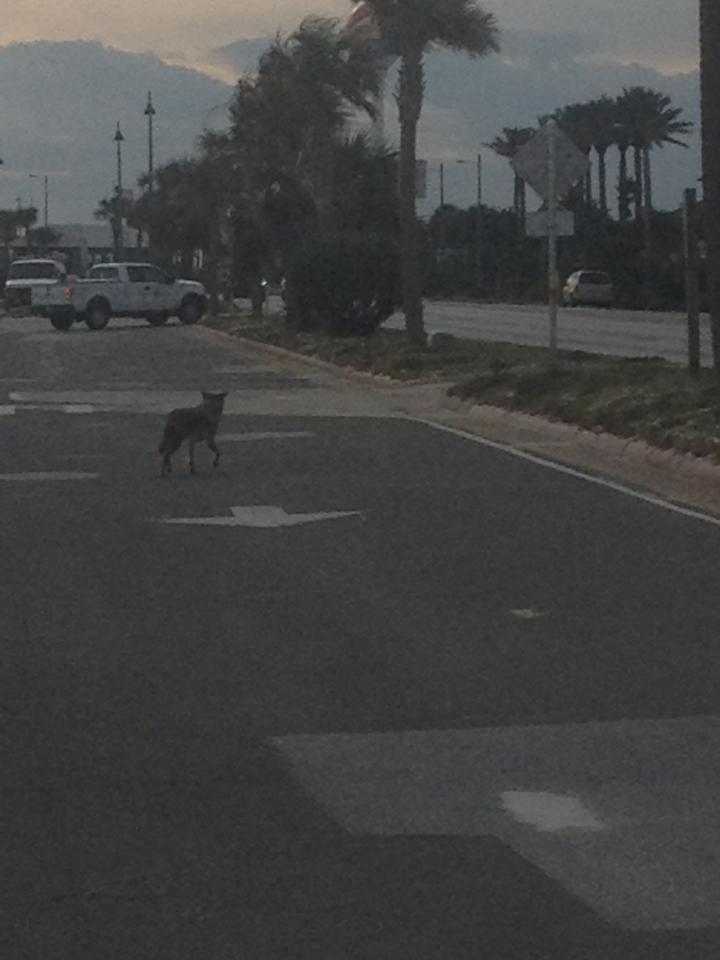
by Rick O'Connor | Apr 14, 2018
In my job, I get many calls about snakes. Most people want to know how to tell a venomous from a nonvenomous one and how to keep them out of the yard. I was recently reading a new book out by Dr. Sean Graham entitled American Snakes and in the chapter on snake defenses, he provided a long litany of local creatures who consumed snakes – some surprised me. Check this out…
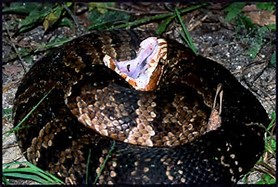
The “cottonmouth” gape of this venomous snakes is a warning. Notice the banded coloration of this individual.
Photo: UF IFAS Wildlife
First, most who do only consume smaller species of snakes – but the list is still surprising. Spiders… spiders were on the list. He specifically called out the black widow – who probably could kill a small snake, but indicated there were others. Scorpions, centipedes, fire ants, carpenter ants, giant water bugs, crayfish, and crabs made the list as well. Some of these may consume snakes only after they are dead – but some can kill small ones.
From the vertebrate world he mentions the larger salamanders (such as the hellbender), and other snakes (such as the short-tailed snake and the coral snake). There are several mammals including shrews, moles, and even the rodents themselves are consumers of snakes! He describes how hoofed mammals (such deer, goat, and horses) do not consume snakes, but can completely destroy one by raising and stopping on them – leaving only small segments remaining. They have found the remains of snakes in the stomachs of all predatory mammals but the snake’s greatest threat are birds… by a long shot. Species from passerines to raptors have been known to kill and consume snakes.
What about venomous snakes – who consumes rattlesnakes and cottonmouths?
There are surprises here as well…
Bullfrogs… bullfrogs basically consume what they can get into their mouths but this includes snakes – and venomous ones as well (though they would be small ones). From the fish world, both the gar and largemouth bass are known to consume venomous snakes.
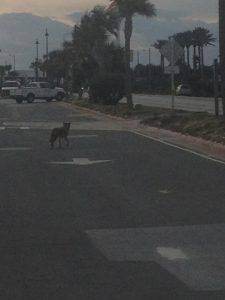
A coyote moving on Pensacola Beach near dawn.
Photo provided by Shelley Johnson.
Opossums are known to consume at least 12 species of snakes, including venomous ones. They also consume ticks, fire ants, and have a very low occurrence of rabies – a cool animal to have around.
Other mammal consumers of venomous snakes include raccoons, otters, fox, bobcats, coyotes, and black bears. It is understood they must take smaller members of the venomous snake population – but a snake control is snake control.
Most wading birds in our marshes consume snakes, including venomous ones, but it is the red-tailed hawk and the great horned owl that are the masters. Red-tailed hawks are known to consume at least 35 species of snakes, including venomous ones, and – unlike other snake predators – are a larger part of their diet, they seek them out. Great Horned Owls consume at least 13 species, and venomous ones are on the menu.
From the reptile world we begin with the alligator, who has little problem consuming large specimens of both the rattlesnake and the cottonmouth. However, many are snakes… yes, snakes eat snakes and some consume venomous ones. Coral snakes, coachwhips, and cottonmouths have been known to consume other snakes. However, it is the Eastern Indigo and the Kingsnakes who actively seek out venomous species. It is known that kingsnakes have a protein in their blood that makes them immune to the viper’s venoms – and it appears the vipers know this and avoid them. It is not known whether the indigo is immune, but it is known they will seek out venomous snakes and consume. Both of these snakes can take relatively large venomous species.
Of these two, it is the Kingsnake who is the “king” – consuming at least 40 species of snakes. However, both the kingsnakes and the indigo are on the declined. The eastern indigo is currently federally listed as endangered – there has not been a verified record of one in the Florida panhandle since 1997. However, there are anecdotal reports and we encourage anyone who has seen one to send us a photograph. There is an active indigo restoration program going on in Alabama and in the Apalachicola River area. These are the largest native snakes in the U.S. (about 8 feet) and, along with the six-foot kingsnakes, are frequently killed. There is evidence that as the eastern kingsnake populations decline copperhead populations increase, and Vis versa. Some areas near Atlanta are currently experiencing a copperhead “boom”. Clearly, we should reconsider killing both the indigo and kingsnakes. We also understand that habitat loss is another cause of their decline, particularly in the case of the indigo.
When looking at this list of snake consumers we see species that cause other problems – alligators, raccoons, coyotes, and bears have all have had their negative issues. But many we just do not like, such as the opossum, really cause us no harm and control snake populations. Everything has its place in the local environment and not one species seeks out humans for the purpose of harming us – this would include snakes. The negative encounters are for other reasons. But for those who have a deep fear, or are currently experiencing high snake numbers, seeing one of the animals on this in the neighborhood could be a relief.
References
Graham, S. 2018. American Snakes. John Hopkins University Press. Baltimore MD. Pp 293.
O’Connor, M. 2018. Personal communication.
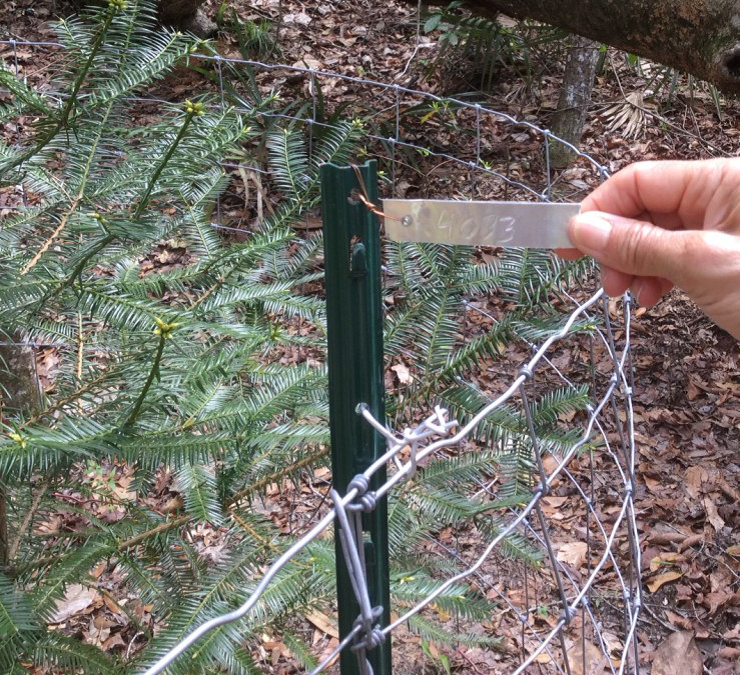
by Sheila Dunning | Apr 14, 2018
Having just completed the Okaloosa/Walton Uplands Master Naturalist course, I would like to share information from the project that was presented by Ann Foley.
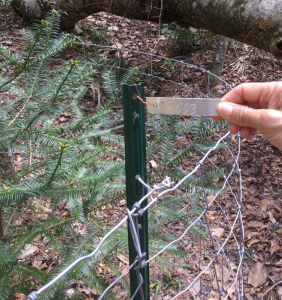
The Florida Torreya. Photo provided by Shelia Dunning
The Florida Torreya is the most endangered tree in North America, and perhaps the world! Less than 1% of the historical population survives. Unless something is done soon, it may disappear entirely! You can see them on public lands in Florida at Apalachicola Bluffs and Ravines Preserve and beautiful Torreya State Park.
The Florida Torreya (Torreya taxifolia) is one of the oldest known tree species on earth; 160 million years old. It was originally an Appalachian Mountains ranged tree. As a result of our last “Ice Age” melt, retreating Icebergs pushed ground from the Northern Hemisphere, bringing the Florida Torreya and many other northern plant species with them.
The Florida Torreya was “left behind” in its current native pocket refuge, a short 40 mile stretch along the banks of the Apalachicola River. There were estimates of 600,000 to 1,000,000 of these trees in the 1800’s. Torreya State Park, named for this special tree, is currently home to about 600 of them. Barely thriving, this tree prefers a shady habitat with dark, moist, sandy loam of limestone origin which the park has to offer.
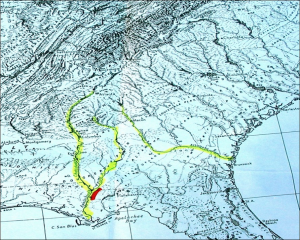
Hardy Bryan Croom, Botanist, discovered the tree in 1833, along the bluffs and ravines of Jackson, Liberty and Gadsen Counties, Florida and Decatur County in Georgia. He named it Florida Torreya (TOR-ee-uh), in honor of Dr. John Torrey, a renowned 18th century scientist.
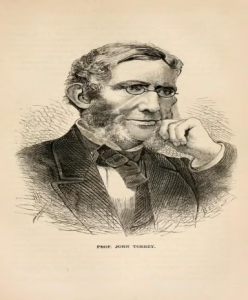
Torreya trees are evergreen conifers, conically shaped, have whorled branches and stiff, sharp pointed, dark green needle-like leaves. Scientists noted the Torreya’s decline as far back as the 1950’s! Mature tree heights were once noted at 60 feet, but today’s trees are immature specimens of 3-6 feet, thought to be ‘root/stump sprouts.’
Known locally as “Stinking Cedar,” due to its strong smell when the leaves and cones are crushed, it was used for fence posts, cabinets, roof shingles, Christmas trees and riverboat fuel. Over-harvesting in the past and natural processes are taking a tremendous toll. Fungi are attacking weakened trees, causing the critically endangered species to die-off. Other declining factors include: drought, habitat loss, deer and loss of reproductive capability.
With federal and state protection, the Florida Torreya was listed as an endangered species in 1983. There is great concern for this ancient tree in scientific community and with citizen organizations. Efforts are underway to help bring this tree back from the edge of extinction!
Efforts include CRISPR gene editing technology research being done by the University of Florida Dept. of Forest Resources and Conservation- making the tree more resistant to disease. Torreya Guardians “rewilding and “assisted migration”. Reintroducing the tree to it’s former native range in the north near the Biltmore Estate in Asheville, NC, which has maintained a grove of Torreya trees and offspring since 1939 and supplying seeds for propagation from their healthy forest. Long before saving the earth became a global concern, Dr. Seuss (Theodor Seuss Geisel), spoke through his character the Lorax warning against urban progress and the danger it posed to the earth’s natural beauty. All of these groups, and many others, hope their efforts will collectively help bring this tree back from the brink!
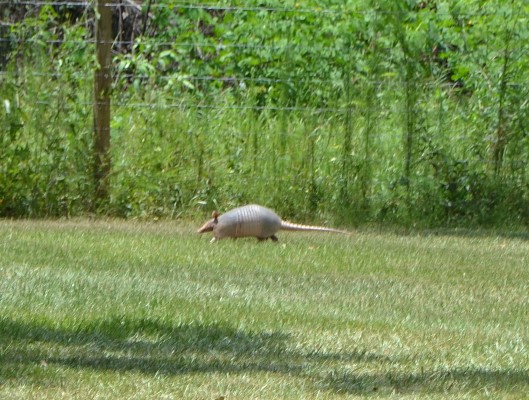
by Les Harrison | Mar 9, 2018
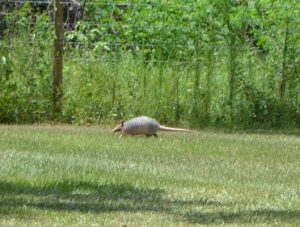
The common nine banded armadillo scurrying across the lawn.
Photo: Les Harrison
The first light of morning can reveal random pockmarks in what had been the perfect lawn the previous evening. The culprit is not likely the neighborhood teenager with a reputation for inappropriate practical jokes.
The offender usually is the nine-banded armadillo, sometimes referred to as a Florida-speed-bump or Possum-on-the-half-shell. In addition to manicured landscapes, they also encroach in natural areas and destroy sensitive habitats.
Armadillos eat adult insects and larvae, but also quail and turtle eggs. They incessantly dig holes in their search for food, many times uprooting plants in their food search. Their foraging holes are approximately one to three inches deep and three to five inches wide.
Using insecticides in landscapes to decrease the armadillo food supply is not guaranteed, but may help reduce the digging. In cases where there is a large, and always ravenous, armadillo population this reduction of food may increase digging activity as they search more diligently for a smaller food supply.
Another consideration is all chemical treatments have to be reapplied on a permanent basis for long term control. Always read and follow label instructions for safe use of insecticides.
Armadillos rest in a deep burrow during the day and are usually active after dark. Burrows openings are approximately seven to eight inches in diameter, about the size of a one-gallon plastic jug, and up to 15 feet in length.
This exotic invasive may burrow under driveways, foundations and patios potentially causing structural damage. Additionally, their burrows in pastures pose a potential leg-injury hazard to large wildlife and livestock.
Several live-trapping techniques can be used to capture armadillos as they exit of their burrows. Because armadillos are nocturnal, trapping techniques designed to capture them as they emerge from their burrows should be applied late in the afternoon and checked several hours after darkness.
Fencing is another option to discourage the presence of armadillos. Relocating captured animals is illegal and not recommended because it only transfers the problem elsewhere and can spread this problem species.
Fossil records indicate the armadillo’s ancestors were as large as modern-day rhinos. One can only imagine what front yards would look like if they still existed.

by Rick O'Connor | Jan 19, 2018
In the last article, we discussed what phytoplankton are, what their needs were, and their importance to marine life throughout the Gulf and coastal estuaries. In this article, we will discuss the different types of phytoplankton found in our waters.
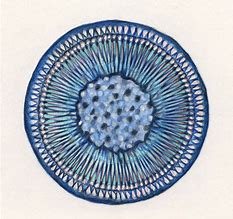
The spherical shape of the centric diatom.
Image: Florida International University
Marine scientists interested in the diversity and abundance of phytoplankton will typically sample using a plankton net. There are a variety of different shapes and sizes of these nets, but the basic design would be funnel shaped with a sample jar attached at the small end of the funnel. The plankton net would be towed behind the research vessel at varying depths for a set period of time. All plankton collected would be analyzed via a microscope. According to the text Identifying Marine Phytoplankton (1997) there are at least 14,000 species of phytoplankton and some suggest as many as 120,000. Most of these, 12,000-100,000, are diatoms, one of five classes of marine phytoplankton. The majority of the phytoplankton fall into one of two class, the diatoms and the dinoflagellates.
Diatoms are typically single celled algae encased in a clear silica shell called a frustule. The frustule can come in a variety of shapes, with or without spines, and many resemble snowflakes – their quite beautiful. They are found in the bay and Gulf in great numbers, as many as 40,000,000 cells / cup of seawater. They are the dominate phytoplankton in colder waters and are most abundant near upwellings. These are the “grasses of the sea” and the base of many marine food webs. When diatoms die, their silica shells sink to the seafloor forming layers of diatomaceous earth, which is used in filters for aquariums and oxygen mask in hospitals.
Dinoflagellates differ from diatoms in that they produce two flagella, small hair-like projections from the algae that are used for generating water currents and movement. Their shells are not silica but layers of membranes and are called thecas. Some membranes are empty and others contain different types of polysaccharides. Dinoflagellates are more abundant than diatoms in warmer waters. There are about 2000 species of them. One type, Noctiluca, are responsible for what locals call “phosphorus” or bioluminescence. These dinoflagellates produce a blue-ish light when disturbed. Many see this when walking the beach at night. Their footprints glow for a few seconds. At night, boaters can see this as their prop wash turns the dinoflagellates in the water column. The bioluminescence is more pronounced in the warm summer months and is believed to be defense against predation. The light is referred to as “cool” light in that the majority of the energy is used in producing light, not lost as heat as with typical incandescent bulbs – hence the birth of the LED light industry.
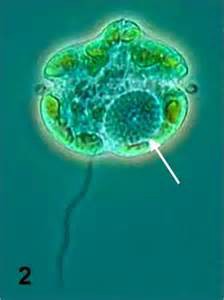
The dinoflagellate Karenia brevis.
Photo: Smithsonian Marine Station-Ft. Pierce FL
Several dinoflagellates produce toxins as a defense. Some generate what we call red tides. In the Gulf of Mexico, Karenia brevis is the species most responsible for red tide. Red tides typical form offshore and are blown into coastal areas via wind and currents. They are common off the coast of southwest Florida but occur occasionally in the panhandle. Many local red tides are actually formed in southwest Florida and pushed northward via currents. Red tides are known to kill marine mammals and fish, as well as closing areas for shellfish harvesting.
Like true plants, phytoplankton conduct photosynthesis. Between the diatoms and dinoflagellates, 50% of the planet’s oxygen is produced. These are truly important players in the ecology of both the open Gulf and local bays.
References
Annett, A.L., D.S. Carson, X. Crosta, A. Clarke, R.S. Ganeshram. 2010. Seasonal Progression of Diatom
Assemblages in Surface Waters of Ryder Bay, Antarctica. Polar Biology vol 33. Pp. 13-29.
Hasle, G.R., E.E. Syvertsen. 1997. Identifying Marine Phytoplankton. Academic Press Harcourt Brace and
Company. San Diego CA. edited by C.R. Tomas. Pp. 858.
Steidinger, K.A., K. Tangen. 1997. Identifying Marine Phytoplankton. Academic Press Harcourt Brace and
Company. San Diego CA. edited by C.R. Tomas. Pp. 858.
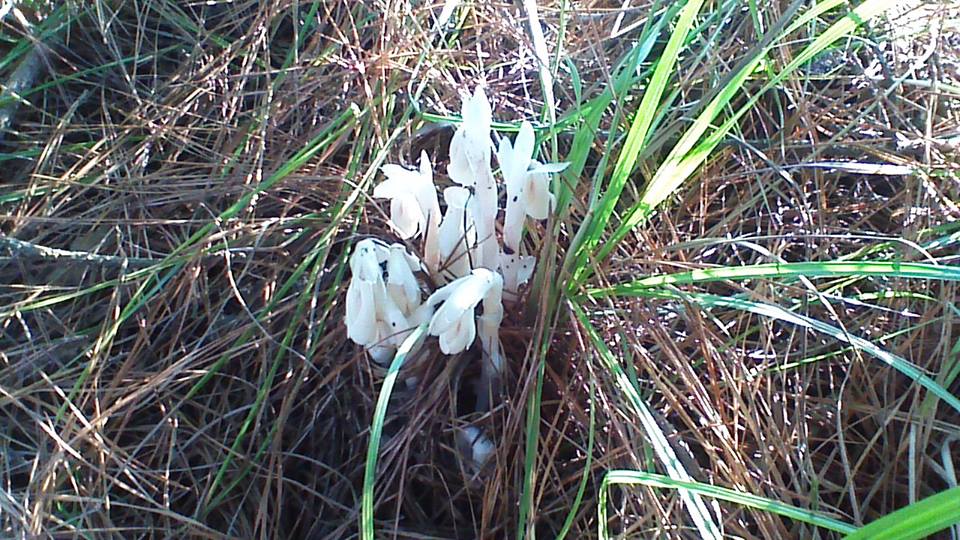
by Carrie Stevenson | Jan 5, 2018
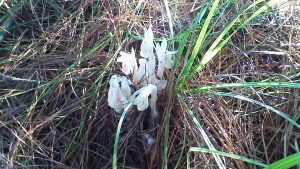
The ghost flower in full bloom. Photo credit: Carol Lord
Imagine you are enjoying perfect fall weather on a hike with your family, when suddenly you come upon a ghost. Translucent white, small and creeping out of the ground behind a tree, you stop and look closer to figure out what it is you’ve just seen. In such an environment, the “ghost” you might come across is the perennial wildflower known as the ghost plant (Monotropa uniflora, also known as Indian pipe). Maybe it’s not the same spirit from the creepy story during last night’s campfire, but it’s quite unexpected, nonetheless. The plant is an unusual shade of white because it does not photosynthesize like most plants, and therefore does not create cholorophyll needed for green leaves.
In deeply shaded forests, a thick layer of fallen leaves, dead branches, and even decaying animals forms a thick mulch around tree bases. This humus layer is warm and holds moisture, creating the perfect environment for mushrooms and other fungi to grow. Because there is very little sunlight filtering down to the forest floor, the ghost flower plant adapted to this shady, wet environment by parasitizing the fungi growing in the woods. Ghost plants and their close relatives are known as mycotrophs (myco: fungus, troph: feeding).
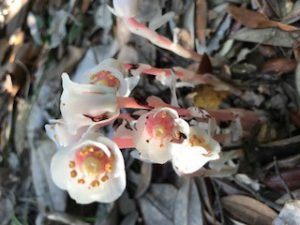
Ghost plant in bloom at Naval Live Oaks reservation in Gulf Breeze, Florida. Photo credit: Shelley W. Johnson
These plants were once called saprophytes (sapro: rotten, phyte: plant), with the assumption that they fed directly on decaying matter in the same way as fungi. They even look like mushrooms when emerging from the soil. However, research has shown the relationship is much more complex. While many trees have symbiotic relationships with fungi living among their root systems, the mycotrophs actually capitalize on that relationship, tapping into in the flow of carbon between trees and fungi and taking their nutrients.
Mycotrophs grow throughout the United States except in the southwest and Rockies, although they are a somewhat rare find. The ghost plant is mostly a translucent shade of white, but has some pale pink and black spots. The flower points down when it emerges (looking like its “pipe” nickname) but opens up and releases seed as it matures. They are usually found in a cluster of several blooms.
The next time you explore the forests around you, look down—you just might see a ghost!
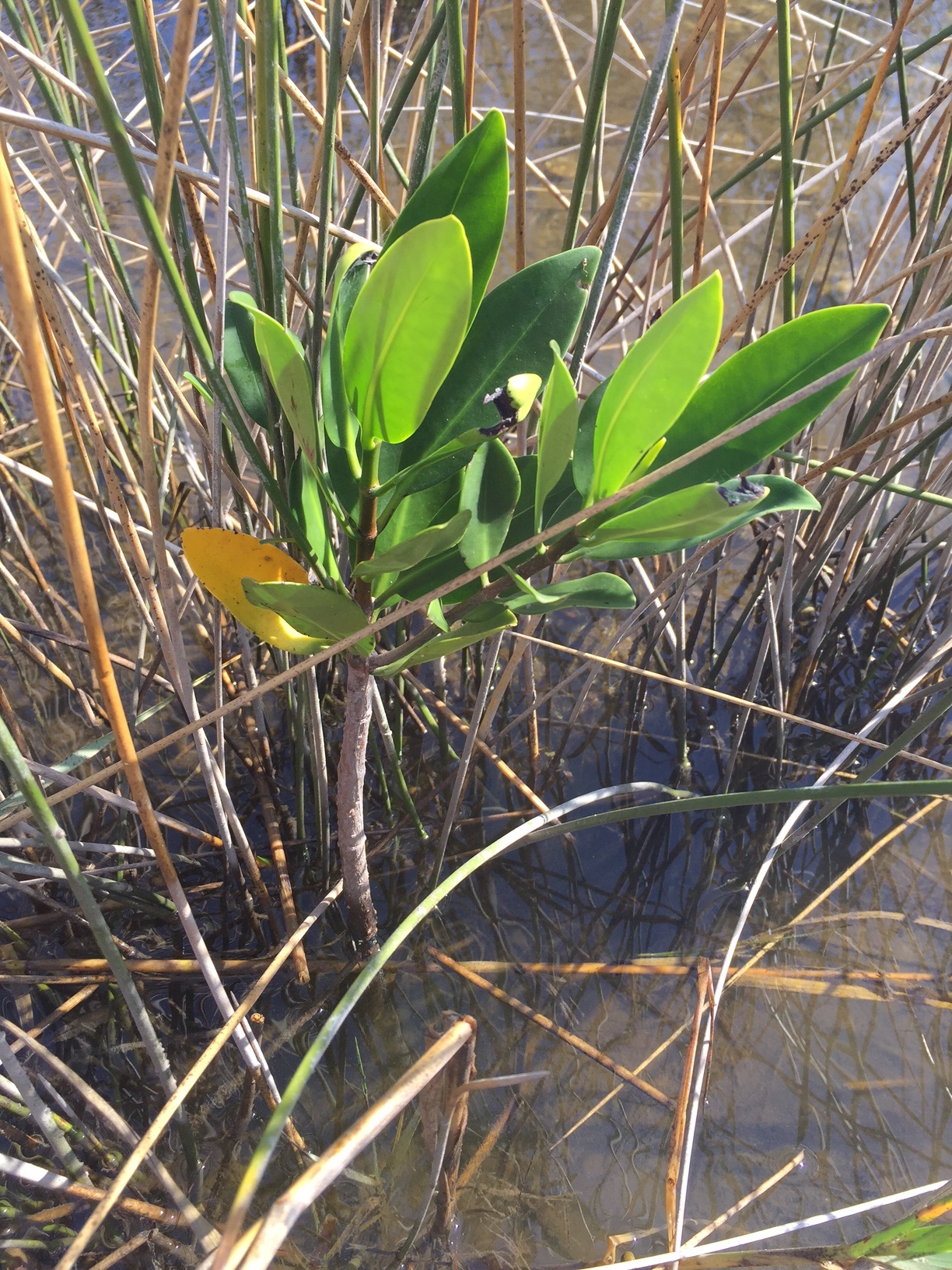
by Carrie Stevenson | Nov 3, 2017

Red mangrove growing among black needlerush in Perdido Key. Photo credit: Carrie Stevenson, UF IFAS Extension
Discovering something new is possibly the most exciting thing a field biologist can do. As students, budding biologists imagine coming across something no one else has ever noticed before, maybe even getting the opportunity to name a new bird, fish, or plant after themselves.
Well, here in Pensacola, we are discovering something that, while already named and common in other places, is extraordinarily rare for us. What we have found are red mangroves. Mangroves are small to medium-sized trees that grow in brackish coastal marshes. There are three common kinds of mangroves, black (Avicennia germinans), white (Laguncularia racemosa), and red (Rhizophora mangle).
Black mangroves are typically the northernmost dwelling species, as they can tolerate occasional freezes. They have maintained a large population in south Louisiana’s Chandeleur Islands for many years. White and red mangroves, however, typically thrive in climates that are warmer year-round—think of a latitude near Cedar Key and south. The unique prop roots of a red mangrove (often called a “walking tree”) jut out of the water, forming a thick mat of difficult-to-walk-through habitat for coastal fish, birds, and mammals. In tropical and semi-tropical locations, they form a highly productive ecosystem for estuarine fish and invertebrates, including sea urchins, oysters, mangrove and mud crabs, snapper, snook, and shrimp.
Interestingly, botanists and ecologists have been observing an expansion in range for all mangroves in the past few years. A study published 3 years ago (Cavanaugh, 2014) documented mangroves moving north along a stretch of coastline near St. Augustine. There, the mangrove population doubled between 1984-2011. The working theory behind this expansion (observed worldwide) is not necessarily warming average temperatures, but fewer hard freezes in the winter. The handful of red mangroves we have identified in the Perdido Key area have been living among the needlerush and cordgrass-dominated salt marsh quite happily for at least a full year.
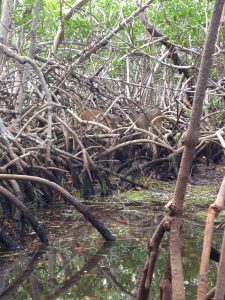
Key deer thrive in mangrove forests in south Florida. Photo credit: Carrie Stevenson, UF IFAS Extension
Two researchers from Dauphin Island Sea Lab are planning to expand a study published in 2014 to determine the extent of mangrove expansion in the northern Gulf Coast. After observing black mangroves growing on barrier islands in Mississippi and Alabama, we are working with them to start a citizen science initiative that may help locate more mangroves in the Florida panhandle.
So what does all of this mean? Are mangroves taking over our salt marshes? Where did they come from? Are they going to outcompete our salt marshes by shading them out, as they have elsewhere? Will this change the food web within the marshes? Will we start getting roseate spoonbills and frigate birds nesting in north Florida? Is this a fluke due to a single warm winter, and they will die off when we get a freeze below 25° F in January? These are the questions we, and our fellow ecologists, will be asking and researching. What we do know is that red mangrove propagules (seed pods) have been floating up to north Florida for many years, but never had the right conditions to take root and thrive. Mangroves are native, beneficial plants that stabilize and protect coastlines from storms and erosion and provide valuable food and habitat for wildlife. Only time will tell if they will become commonplace in our area.
If you are curious about mangroves or interested in volunteering as an observer for the upcoming study, please contact me at ctsteven@ufl.edu. We enjoy hearing from our readers.


















